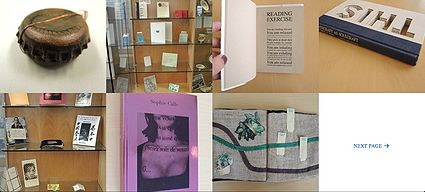LIBR 559M Wiki Assignment: Social Media in Special Collections
The socially based promotion of special collections in libraries and other institutions is not a new phenomenon. The joining of special collections and social media builds on approaches that libraries in general have been using for quite some time. In order to increase user participation, libraries have been looking at different strategies for promotion and awareness, and social media increasingly forms a large part of these efforts.[1]
Statistics collected from a social media and special collections wiki show 185 institutions on Twitter, 115 with Tumblrs, and 170 blogs in this field.[2] These numbers do not include individual librarians, researchers, collectors, and dealers on those platforms.[3]
Definitions
Social media
Social media has been used as a buzzword to encompass a variety of digital acts of communication and sharing.[4] Since social behavior is something that has existed for millennia, and the media is an ever changing, expanding and evolving entity, a clear and simple definition of what social media is can be hard to find and is often prefaced with “it’s complicated”. The Oxford Dictionary defines social media as “websites and applications that enable users to create and share content or to participate in social networking.”[5]
Special collections
Special collections in libraries exist in order to protect and preserve materials such as rare books, manuscripts, photographs, archives, and digital records[6]. The protection and preservation of these materials make perfect sense; however, there may be tension between the need for preservation and the desire to use these materials to reach out to audiences. Social media can circumvent this barrier by letting the materials stay in their physical site while also being promoted through digital domains.
Considerations for use
Positive Aspects
Expanding audiences
Social media promotion is ideal for institutions that view their audience as consisting of more than a geographically bound user population and want to grow their brand and awareness through virtual means.
Social media use can help to showcase what is unique about the institution, making it stand out from other libraries and competitors. Promoting content, especially when that material is available digitally, has the potential to direct people to the library and to bring the content to the user instead of vice versa. It is a way of demonstrating value in the institution when that value may not be immediately apparent. Librarians and archivists faced with collections that may be locked away or suffer from poor circulation can in effect use their collections to raise awareness of the collections.
Adding sociality
In addition to promotion, the social component of digital media is important. It affords the chance of connections and services beyond those possible in the physical building, establishing the library as a social institution and not merely a curatorial one. The communication network that can be built through social media in special collections allows access to not only the materials in the collections but also to the intimate conversations between curators and collections that was once only accessible to those working in these spaces. Now these conversations can happen in spaces like Facebook, Twitter, and blogs where users feel they have something to add to the collections. It is also a means of sharing with other libraries and exchanging ideas for what can be done with their specific collections.
Social media allows libraries to get the word out about what they are doing, share their expressions and feelings about it, and provide information on just what makes them special, unique, and original. In order to keep this information current, interesting, and have it reach more people, libraries will need to build a path for audiences and participants to find them, follow them, and keep listening. Social media creates many possibilities, but like anything that is worth doing, it is an investment of time, resources and energy.
Critiques
Social media use in libraries has been researched and critiqued by a number of scholars in the field. (e.g. Winner, 1988, Chu & Meuleman 2008, Dumpter, 2009)[7] A research study on social media and university libraries conducted by CIBER researchers identified a number of critiques or limitations of social media use within libraries at three major British research universities and one scholarly publisher.[8]
Some critiques are:
- Libraries are an afterthought when it comes to larger institutional social media strategies.
- A lack of clarity on whose territory social media falls under leads to lack of funding for these initiatives.
- A view of libraries as bounded spaces that do not provide access to borderless types of information means social media is not seen as a library domain.
- A lack of enthusiasm among librarians for social media.
- Social media has a tendency to offer "information lite" and is not regarded as legitimate.
In responding to critiques of social media use, particularly in special collections, Sarah Werner's work How to Destroy Special Collections with Social Media[9] uses a tongue in cheek approach to discuss ways that special collections can benefit from the use of social media.
Guidelines for use
Because the intersections of social media promotion and special collections are both decentralized and relatively new, there are no primary authorities on the subject. Many institutions and individuals have shared guides and primers based on their own experiences and practices.[10][11]
Choosing a platform
Dedicated accounts for special collections may not be for every organization. Many small libraries may be better served incorporating special collections as part of their regular social media promotion of news, events, and the general collection.
If separate special collections accounts are deemed necessary, the platforms used should be based on the expected needs and habits of the actual and desired audiences. Academic libraries that host large populations of engaged youth may find success with platforms popular with younger users, such as Snapchat and Instagram. Public libraries with lots of families in the service area may see high engagement with a Facebook page sharing posts aimed at middle-aged parents.
Institutions should also consider the unique affordances of each platform, since the combinations of features are different for each one. Platforms may limit length of posts, as with Twitter's 144-character limit, have unique feedback tools, such as liking on Facebook and upvoting and downvoting on Reddit, or feature time-sensitive content, like on Snapchat. In general, platforms should support visual content such as photos and videos, which are stickier than purely text-based posts.
Another important aspect is time management. Using platforms that connect themselves to others, such as Instagram to Facebook, can save time when disseminating content, as can tools such as IFTTT and HootSuite.
Assessment and return on investment
Assessing the professional value of social media use and engagement within special collections is a fairly new undertaking for many North American libraries, but assessment as a tool is critical for libraries to be able to justify the effort of maintaining an online presence to stakeholders and their parent institution. Assessment tools provide an excellent opportunity for the library measure important elements such as the impact, effort, and value of doing social media work on a continual basis. Scholarly literature is beginning to acknowledge this issue. For example, a recent empirical investigation introduces readers to the concept of applying “return on investment” (ROI) as an assessment tool for libraries who engage in social media for their special collections.[12]
Griffin et. al. completed an extensive empirical study in 2013 by examining social media usage in special collections departments of current ARL (Association of Research Libraries) members. The authors believed that “analyzing publicly available data from profiles on a variety of social media platforms” could help them better understand how special collections units “employ social networking tools, and whether it is possible to determine success in terms of benefits received by the department, such as increased dialogue between departments and supports.”[13] Put more simply, the authors wanted to find out the extent to which the social media is encouraging participatory engagement between users, the collection, and the library.
As a tool, ROI can assess the value or benefit of an investment based on a simple equation: net profit divided by investment. Applying this concept is a way for libraries to assess “actual value of social media engagement by using likes, shares, followers, and friends for net profits and staff energy and time for investment costs.[14] For example, if a library’s Facebook page had 304 comments posted to Facebook updates in 47 posts over 1 month of a given year, the number of comments (304, net profit) would be divided by the number of posts (47, investment) to arrive at a percentage of nearly 647% ROI. This is particularly useful as an assessment tool as the resulting data can help justify staffing time dedicated to a social media librarian or similar role. The authors acknowledge that the idea of “engagement” can’t truly be defined by likes and shares, but also that they remain indicative that these platforms do help promote the library, its collections, and its relevance on a local and global scale.
Current uses
Examples of libraries and archives promoting special collections through social media:
| Institution | Social Media Platform(s) |
|---|---|
| University of Iowa | Tumblr, Instagram, Twitter |
| University of Wisconsin - Milwaukee | Tumblr, Facebook |
| University of Missouri | Tumblr, Twitter, Facebook |
| Folger Shakespeare Library | Twitter, Facebook,Flickr |
| The Banff Centre Paul D. Fleck Library & Archives | Tumblr |
| Royal Astronomical Society |
References
- ↑ Green, Daryl. (2012, June) “Utilizing social media to promote Special Collections: What works and what doesn’t” 2012 IFLA WLIC , Helsinki Finland. Retrieved January 24, 2016 from http://conference.ifla.org/past-wlic/2012/87-green-en.pdf
- ↑ Special Collections + Social Media [licensed for non-commercial use only] / Special Collections and Social Media. (n.d.). Retrieved January 25, 2016, from http://specialcollectionssocialmedia.pbworks.com/w/page/67443183/Special%20Collections%20and%20Social%20Media
- ↑ Werner, S. (2015, July 31). How to Destroy Special Collections with Social Media. Retrieved January 24, 2016 from http://sarahwerner.net/blog/2015/07/how-to-destroy-special-collections-with-social-media/
- ↑ boyd, danah. 2009. "Social Media is Here to Stay... Now What?" Microsoft Research Tech Fest, Redmond, Washington, February 26. Retrieved January 22, 2016 from http://www.danah.org/papers/talks/MSRTechFest2009.html
- ↑ social media: Learner’s Dictionary. (n.d.). Retrieved January 22, 2016 from http://www.oxforddictionaries.com/definition/learner/social-media
- ↑ Special collections. (2015, November 26). In Wikipedia, the free encyclopedia. Retrieved from https://en.wikipedia.org/w/index.php?title=Special_collections&oldid=692555962
- ↑ Jonathan Bodnar & Ameet Doshi (2011) Asking the Right Questions: A Critique of Facebook, Social Media, and Libraries, Public Services Quarterly, 7:3-4, 102-110, DOI: 10.1080/15228959.2011.6235.
- ↑ Nicholas, D., Watkinson, A., Rowlands, I., & Jubb, M. (2011). Social media, academic research and the role of university libraries. The Journal of Academic Librarianship, 37(5), 373–375.
- ↑ Werner, S. (2015, July 31). how to destroy special collections with social media. Retrieved January 24, 2016 from http://sarahwerner.net/blog/2015/07/how-to-destroy-special-collections-with-social-media/
- ↑ Hopman, Rebecca. "Social Media." Personal website. Retrieved January 26, 2016 from http://rebeccahopman.com/socialmedia/
- ↑ Chowcat, Ian, Kay, David, and Stephens, Owen. "Using Social Media to Promote Your Digital Collections." Jisc. Retrieved January 26, 2016 from https://www.jisc.ac.uk/guides/using-social-media-to-promote-your-digital-collections
- ↑ Griffin, M., & Taylor, T. I. (2013). Of fans, friends, and followers: Methods for assessing social media outreach in special collections repositories. Journal of Web Librarianship, 7(3).
- ↑ Griffin, M., & Taylor, T. I. (2013). Of fans, friends, and followers: Methods for assessing social media outreach in special collections repositories. Journal of Web Librarianship, 7(3), 255.
- ↑ Griffin, M., & Taylor, T. I. (2013). Of fans, friends, and followers: Methods for assessing social media outreach in special collections repositories. Journal of Web Librarianship, 7(3), 267.


